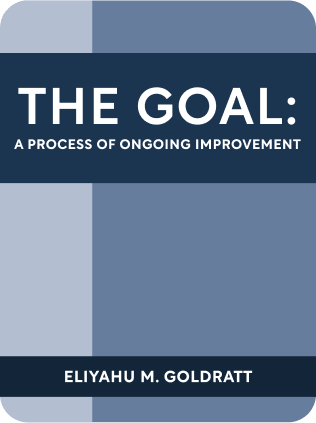

This article is an excerpt from the Shortform book guide to "The Goal: A Process of Ongoing Improvement" by Eliyahu M. Goldratt. Shortform has the world's best summaries and analyses of books you should be reading.
Like this article? Sign up for a free trial here .
Are you looking quotes from The Goal? What are key passages from the book?
The Goal quotes focus on the most important aspects of the book. These three selected passages will help inspire your productivity and output.
Keep reading for three The Goal quotes to learn.
Quotes from The Goal
“So this is the goal: To make money by increasing net profit, while simultaneously increasing return on investment, and simultaneously increasing cash flow.”
The first of the quotes from The Goal explains the title of the book. The Goal of every business is to make money. Likewise, activities that do not bring you closer to making money are not productive.
- Beware of defining subgoals that do not really drive toward the Goal, like production efficiency, team size, money raised, etc.
Organizations can be measured by 3 metrics: Throughput, Inventory, and Operational Expense.
- Throughput: the rate at which the system generates money through sales
- Inventory: all the money system has invested in purchasing things it intends to sell
- Operational expense: all the money the system spends to turn inventory into throughput
Ideally, your activities improve all three at once.
- Many companies focus primarily on decreasing operating expense, which can lead to unproductive behaviors that stifle throughput. Instead, switch your mindset to increasing throughput.
“What you have learned is that the capacity of the plant is equal to the capacity of its bottlenecks,” says Jonah.”
The second of the quotes from The Goal is all about the recurring theme of bottlenecks. Any time that the bottleneck isn’t working is lost time forever that cannot be made up at any other part in the system.
An hour lost at the bottleneck causes a loss in total throughput equal to the hourly capacity of that bottleneck. This is an important concept.
- If the total throughput is a thousand dollars per hour, then the bottleneck is processing at a thousand dollars per hour, even if the literal operational costs or the parts going through it cost much less.
- Alternatively, take the entire operating expense of the factory, divided by the hours worked by the bottleneck – that’s the actual cost of the bottleneck.
In other words, a loss in the bottleneck means a loss to the entire operation, and should be viewed with such gravity
Other losses in effective throughput are also similarly costly. For example, feeding low-quality parts through the bottleneck will cause rejection later, leading to effectively lower throughput.
While time lost from the bottleneck can be made up for by hurrying non-bottlenecks, any extra effort here typically adds to operational expense (eg overtime pay). Ideally, the bottleneck is simply maintained at peak capacity at all times.
“Since the strength of the chain is determined by the weakest link, then the first step to improve an organization must be to identify the weakest link.”
The importance of addressing bottlenecks is at the heart of the third of the quotes from The Goal. Imagine a troop of 10 boys hiking single-file on a narrow trail in the woods. The leader of the pack sets a comfortable pace that everyone on average should be able to meet.
Every boy is only able to catch up to the boy in front – he can’t pass the boy in front. Thus, the speed of each boy is constrained by the boy in front.
Analogy to manufacturing: the first boy is the most upstream step; the last boy measures throughput; the distance in between is inventory.
Here’s an example of a negative fluctuation
- Say the 3rd boy in line stops to tie his shoes, increasing the gap between him and the 2nd boy. The 4th boy runs into the 3rd boy and has to match his slower pace. Even if he could walk faster, the 4th boy is constrained.
- The 3rd boy gets back up and hurries to make up the distance to the 2nd boy. But the 4th boy is already tired and can’t jog, thus increasing the lag.
- These fluctuations happen at different points throughout the chain. The 6th boy gets tired and holds up the 7th boy, who is energetic but can’t get past the 6th. Then as the 6th boy regains steam, the 7th boy gets tire and lags behind.
- Inevitably, even though all the boys are at the same average rate, the gap between first and last boy increases. The fluctuations are accumulating because the ability to go faster than average is restricted by your upstream step.
- This gap can be closed only if the last boy – and all the boys in front of him – all move much faster than the first boy.
Let’s say to relieve these pesky dependencies, you order all the boys in speed, with fastest leading the pack. All boys can now move unconstrained and operate at their individual peak efficiencies. However, the distance between the first boy and the last boy will incrementally grow, unbounded.
- This is what happens when you concentrate on single-step efficiency without focusing on throughput. All steps are working at full steam, but inventory progressively increases. The fastest step is churning out work ceaselessly, but the other steps can’t catch up.
To solve this accumulating gap, let’s try a new solution: order the boys with slowest first and holding up the line for all other boys. On the surface, this seems very inefficient – the other boys are nowhere near their peak efficiency, and they’re all running into the next boy.
However, there are a few key advantages:
- The bottleneck is now quite obvious. We can now increase throughput by speeding up the slowest boy in front. For instance, we can redistribute the slowest boy’s backpack load to the other boys.
- Inventory – the distance between the first and last boy – is now dramatically reduced. All boys are producing just enough to match the pace of the first slow boy.
This wonderful analogy should make clear the flaws of defining the average of all steps, without regard to the overall throughput and the bottleneck steps. Taken together, these three The Goal quotes help you focus on the key messages of the book.

———End of Preview———
Like what you just read? Read the rest of the world's best book summary and analysis of Eliyahu M. Goldratt's "The Goal: A Process of Ongoing Improvement" at Shortform .
Here's what you'll find in our full The Goal: A Process of Ongoing Improvement summary :
- How to increase your personal output
- How to increase your team's output
- Why obsessing over cost efficiency isn't going to help you with production






